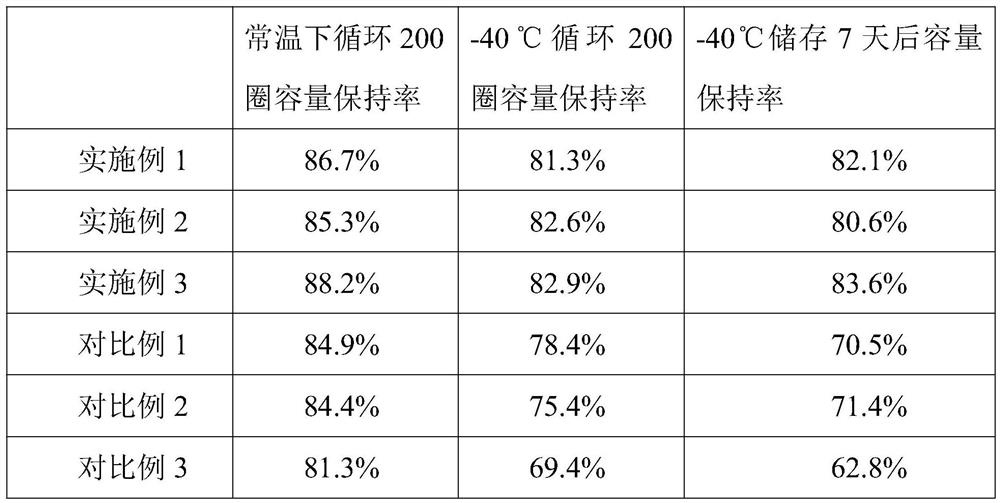A kind of lithium ion battery electrolyte and lithium ion battery
An electrolyte and lithium-ion technology, applied in secondary batteries, organic electrolytes, non-aqueous electrolytes, etc., can solve problems affecting the low-temperature discharge performance of lithium-ion batteries, unusable lithium-ion batteries, and performance degradation of lithium-ion batteries. Effects of improving low-temperature cycle performance and storage performance, increasing lithium ion transfer rate, and optimizing interface properties
- Summary
- Abstract
- Description
- Claims
- Application Information
AI Technical Summary
Problems solved by technology
Method used
Image
Examples
Embodiment 1
[0012] (1) Preparation of electrolyte
[0013] Prepare the electrolyte solution in a glove box filled with argon gas, prepare a mixed solution with ethylene carbonate, ethyl methyl carbonate and propylene carbonate at a mass ratio of 1:1:1, stir evenly, add lithium hexafluorophosphate, additive A and Additive B, wherein, additive A accounts for 1.5 wt% of the total mass ratio of the electrolyte, additive B accounts for 1.5 wt% of the total mass ratio of the electrolyte, and lithium hexafluorophosphate accounts for 13% of the total mass of the electrolyte.
[0014] (2) Assembly of lithium ion battery
[0015] The cathode active material LiNi 0.8 co 0.1 mn 0.1 , conductive agent acetylene black, and binder PVDF are dissolved in the solvent NMP at a mass ratio of 95:3:2 and stirred and mixed to make positive electrode slurry, which is evenly coated on the positive electrode current collector aluminum foil and dried; the negative electrode active material Natural graphite, con...
Embodiment 2
[0017] The difference from Example 1 is that the additive A in the electrolyte accounts for 1% of the total mass of the lithium-ion secondary battery electrolyte, and the additive B in the electrolyte accounts for 2% of the total mass of the lithium-ion secondary battery electrolyte.
Embodiment 3
[0019] The difference from Example 1 is that the additive A in the electrolyte accounts for 2% of the total mass of the lithium-ion secondary battery electrolyte, and the additive B in the electrolyte accounts for 4% of the total mass of the lithium-ion secondary battery electrolyte.
PUM
| Property | Measurement | Unit |
|---|---|---|
| electrical conductivity | aaaaa | aaaaa |
Abstract
Description
Claims
Application Information
 Login to View More
Login to View More - R&D
- Intellectual Property
- Life Sciences
- Materials
- Tech Scout
- Unparalleled Data Quality
- Higher Quality Content
- 60% Fewer Hallucinations
Browse by: Latest US Patents, China's latest patents, Technical Efficacy Thesaurus, Application Domain, Technology Topic, Popular Technical Reports.
© 2025 PatSnap. All rights reserved.Legal|Privacy policy|Modern Slavery Act Transparency Statement|Sitemap|About US| Contact US: help@patsnap.com

